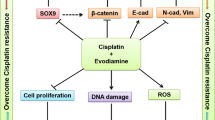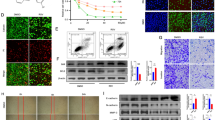Abstract
Glioblastoma Multiforme (GBM) is a malignant primary brain tumor associated with poor survival rate. PI3K/Akt pathway is highly upregulated in gliomas due to deletion or mutation of PTEN and its activation is associated with tumor grade. mTOR is downstream from PI3K/Akt pathway and it initiates translation through its action on S6K and 4E-BP1. mTOR is an important therapeutic target in many cancers, including glioblastomas. Rapamycin and its analogues are known to inhibit mTOR pathway; however, they also show simultaneous upregulation of Akt and eIF4E survival pathways on inhibition of mTOR, rendering cells more resistant to rapamycin treatment. In this study we investigated the effect of combination treatment of rapamycin with isoflavones such as genistein and biochanin A on mTOR pathway and activation of Akt and eIF4E in human glioblastoma (U87) cells. Our results show that combination treatment of rapamycin with isoflavones, especially biochanin A at 50 μM, decreased the phosphorylation of Akt and eIF4E proteins and rendered U87 cells more sensitive to rapamycin treatment when compared to cells treated with rapamycin alone. These results suggest the importance of combining chemopreventive with chemotherapeutic agents in order to increase the efficacy of chemotherapeutic drugs.







Similar content being viewed by others
References
Central Brain Tumor Registry of the Unites States. Statistical report: primary brain tumors in the Unites States, 2000–2004. CBTRUS; 2007-2008
Kufe DW, Pollock RE, Weichselbaum RR et al (2004) Cancer Medicine 6. BC Decker, New York, pp 1195–1231
Jeffrey Bruce: Glioblastoma Multiforme. eMedicine February, (2005)
Baldwin RM, Parolin DA, Lorimer IA (2008) Regulation of glioblastoma cell invasion by PKC iota and RhoB. Oncogene 27(25):3587–3595
Tremont-Lukats IW, Gilbert MR (2003) Advances in molecular therapies in patients with brain tumors. Cancer Control 10(2):125–137
Omuro AM, Faivre S, Raymond E (2007) Lessons learned in the development of targeted therapy for malignant gliomas. Mol Cancer Ther 6(7):1909–1919
Vivanco I, Sawyers CL (2002) The phosphatidylinositol 3-kinase AKT pathway in human cancer. Nat Rev Cancer 2:489–501
Wong AJ, Bigner SH, Bigner DD et al (1987) Increased expression of the epidermal growth factor receptor gene in malignant gliomas is invariably associated with gene amplification. Proc Natl Acad Sci 84:6899–6903
Ohgaki H (2005) Genetic pathways to glioblastomas. Neuropathology 25(1):1–7
Choe G, Horvath S, Cloughesy TF et al (2003) Analysis of the phosphatidylinositol 3′-kinase signaling pathway in glioblastoma patients in vivo. Cancer Res 63:2742–2746
Chakravarti A, Zhai G, Suzuki Y et al (2004) The prognostic significance of phosphotidylinositol 3-kinase pathway activation in human gliomas. J Clin Oncol 22(10):1926–1933
Cheng JQ, Nicosia SV (2001) AKT signal transduction pathway in oncogenesis. Encylopedia reference of cancer. Springer, Berlin, pp 35–37
Koul D, Shen R, Bergh S et al (2006) Inhibition of Akt survival pathway by a small-molecule inhibitor in human glioblastoma. Mol Can Therap 5(3):637–644
Hay N, Sonenberg N (2004) Upstream and downstream of mTOR. Genes Dev 18:1926–1945
Kaper F, Dornhoefer N, Giaccia AJ (2006) Mutation in the PI3K/PTEN/TSC2 pathway contribute to mammalian target of rapamycin activity and increased translation under hypoxic conditions. Cancer Res 66(3):1561–1569
Bjornsti MA, Houghton PJ (2004) The TOR pathway: a target of cancer therapy. Nat Rev Cancer 4:335–348
Hidalgo M, Rowinsky EK (2000) The rapamycin-sensitive signal transduction pathway as a target for cancer therapy. Oncogene 19:6680–6686
Dutcher JP (2004) Mammalian target of rapamycin inhibition. Clin Cancer Res 10:6382–6387
Gingras AC, Raught B, Sonenberg N (2001) Regulation of translation initiation by FRAP/mTOR. Genes Dev 15:807–826
Huang S, Houghton PJ (2002) Inhibitors of mammalian target of rapamycin as novel antitumor agents: from bench to clinic. Curr Opinion Invest Drugs 3:295–304
Dudkin L, Dilling MB, Cheshire PJ et al (2001) Biochemical correlates of mTOR inhibition by the rapamycin ester CC1–779 and tumor growth inhibition. Clin Cancer Res 7:1758–1764
Chen J, Fang Y (2004) A novel pathway regulating the mammalian target of rapamycin (mTOR) signaling. Biochem Pharmacol 64:1071–1077
Wei LH, Su H, Hildebrandt IJ et al (2008) Changes in tumor metabolism as readout for mammalian target of rapamycin kinase inhibition by rapamycin in glioblastoma. Clin Cancer Res 14(11):3416–3426
Reardon DA, Desjardins A, Vredenburgh JJ et al. (2010) Phase 2 trial of erlotinib plus sirolimus in adults with recurrent glioblastoma. J Neurooncol 96(2):219–230
Yu K, Toral-Barza L, Discafani C et al (2001) mTOR, a novel target in breast cancer: the effect of CCI-779, an mTOR inhibitor, in preclinical models of breast cancer. Endocr Relat Cancer 8:249–258
Gao N, Zhang Z, Jiang BH et al (2003) Role of PI3K/AKT/mTOR signaling in the cell cycle progression of human prostate cancer. Biochem Biophys Res Commun 310(4):1124–1132
Galanis E, Buckner JC, Maurer MJ et al (2005) Phase II trial of temsirolimus (CCI-779) in recurrent glioblastoma multiforme: a north central cancer treatment group study. J Clin Oncol 23(23):5294–5304
Duerr EM, Rollbrocker B, Hayashi Y et al (1998) PTEN mutations in gliomas and glioneuronal tumors. Oncogene 16(17):2259–2264
Neshat MS, Mellinghoff IK, Tran C et al (2001) Enhanced sensitivity of PTEN-deficient tumors to inhibition of FRAP/mTOR. PNAS 98(18):10314–10319
Huang S, Houghton PJ (2001) Resistance to rapamycin: a novel anticancer drug. Cancer Metastasis Rev 20(1–2):69–78
Huang S, Houghton PJ (2001) Mechanisms of resistance to rapamycins. Drug Resist Updat 4(6):378–391
Cloughesy TF, Yoshimoto K, Nghiemphu P et al (2008) Antitumor activity of rapamycin in a phase I trial for patients with recurrent PTEN-deficient glioblastoma. PLoS Med 5(1):e8
Rao RD, Mladek AC, Lamont JD et al (2005) Disruption of parallel and converging signaling pathways contributes to the synergistic antitumor effects of simultaneous mTOR and EGFR inhibition in GBM cells. Neoplasia 7(10):921–929
Goudar RK, Shi Q, Hjelmeland MD et al (2005) Combination therapy of inhibitors of epidermal growth factor receptor/vascular endothelial growth factor receptor 2 (AEE788) and the mammalian target of rapamycin (RAD001) offers improved glioblastoma tumor growth inhibition. Mol Cancer Ther 4(1):101–112
Doherty L, Gigas DC, Kesari S et al (2006) Pilot study of the combination of EGFR and mTOR inhibitors in recurrent malignant gliomas. Neurology 67(1):156–158
Kreisl TN, Lassman AB, Mischel PS et al (2009) A pilot study of everolimus and gefitinib in the treatment of recurrent glioblastoma (GBM). J Neurooncol 92(1):99–105
Paternot S, Roger PP (2009) Combined inhibition of MEK and mammalian target of rapamycin abolishes phosphorylation of cyclin-dependent kinase 4 in glioblastoma cell lines and prevents their proliferation. Cancer Res 69(11):4577–4581
Costa LJ, Gemmill RM, Drabkin HA (2007) Upstream signaling inhibition enhances rapamycin effect on growth of kidney cancer cells. Urology 69(3):596–602
Persky V, Van Horn L (1995) Epidemiology of soy and cancer: perspectives and directions. J Nutr 125(3):709S–712S
Barnes S, Peterson TG (1995) Biochemical targets of the isoflavone genistein in tumor cell lines. Proc Soc Exp Biol Med 208(1):103–108
Fotsis T, Pepper M, Adlercreutz H et al (1993) Genistein, a dietary-derived inhibitor of in vitro angiogenesis. Proc Natl Acad Sci USA 90(7):2690–2694
Akiyama T, Ishida J, Nakagawa S et al (1987) Genistein, a specific inhibitor of tyrosine-specific protein kinases. J Biol Chem 262(12):5592–5595
Lee YS, Seo JS, Chung HT et al (1991) Inhibitory effects of biochanin A on mouse lung tumor induced by benzo(a)pyrene. J Korean Med Sci 6(4):325–328
Hempstock J, Kavanagh JP, George NJ (1998) Growth inhibition of prostate cell lines in vitro by phyto-oestrogens. Br J Urol 82(4):560–563
Rice L, Samedi VG, Medrano TA et al (2002) Mechanisms of the growth inhibitory effects of the isoflavonoid biochanin A on LNCaP cells and xenografts. Prostate 52(3):201–212
Penar PL, Khoshyomn S, Bhushan A et al (1997) Inhibition of epidermal growth factor receptor-associated tyrosine kinase blocks glioblastoma invasion of the brain. Neurosurgery 40(1):141–151
Penar PL, Khoshyomn S, Bhushan A et al (1998) Inhibition of glioma invasion of fetal brain aggregates. In Vivo 12(1):75–84
Sehdev V, Lai JC, Bhushan A (2009) Biochanin A modulates cell viability, invasion and growth promoting signaling pathways in HER-2-positive breast cancer cells. J Oncol (In Press)
Puli S, Bhushan A, Lai JC (2006) Inhibition of matrix degrading enzymes and invasion in human glioblastoma (U87MG) cells by isoflavones. J Neurooncol 79(2):135–142
Sun SY, Rosenberg LM, Wang X et al (2005) Activation of Akt and eIF4E survival pathways by rapamycin mediated mammalian target of rapamycin inhibition. Cancer Res 65(16):7052–7058
Hu X, Pandolfi PP, Li Y et al (2005) mTOR promotes survival and astrocytic characteristics induced by Pten/Akt signaling in glioblastoma. Neoplasia 7(4):356–368
Dilling MB, Dias P, Shapiro DN et al (1994) Rapamycin selectively inhibits the growth of childhood rhabdomyosarcoma cells through inhibition of signaling via the type I insulin-like growth factor receptor. Cancer Res 54(4):903–907
Hosoi H, Dilling MB, Liu LN et al (1998) Studies on the mechanism of resistance to rapamycin in human cancer cells. Mol Pharmacol 54:815–824
Eshleman JS, Carlson BL, Mladek AC et al (2002) Inhibition of the mammalian target of rapamycin sensitizes U87 xenografts to fractionated radiation therapy. Cancer Res 62:7291–7297
Heimberger AB, Wang E, McGary EC et al (2005) Mechanism of action of rapamycin in gliomas. Neuro Oncol 7(1):1–11
Haruta T, Uno T, Kawahara J et al (2000) A rapamycin-sensitive pathway down-regulates insulin signaling via phosphorylation and proteasomal degradation of insulin receptor substrate-1. Mol Endocrinol 14(6):783–789
Kim DH, Sarbassov DD, Ali SM et al (2002) mTOR interacts with raptor to form nutrient-sensitive complex that signals to the cell growth machinery. Cell 110:163–175
Oshiro N, Yoshino K, Hidayat S et al (2004) Dissociation of raptor from mTOR is a mechanism of rapamycin-induced inhibition of mTOR function. Genes Cells 9:359–366
Sarbassov DD, Guertin DA, Ali SM et al (2005) Phosphorylation and regulation of Akt/PKB by the rictor-mTOR complex. Science 307(5712):1098–1101
Dowling RJ, Pollak M, Sonenberg N (2009) Current status and challenges associated with targeting mTOR for cancer therapy. Bio Drugs 23(2):77–91
Gulati N, Karsy M, Albert L et al (2009) Involvement of mTORC1 and mTORC2 in regulation of glioblastoma multiforme growth and motility. Int J Oncol 35(4):731–740
Toschi A, Lee E, Xu L et al (2009) Regulation of mTORC1 and mTORC2 complex assembly by phosphatidic acid: competition with rapamycin. Mol Cell Biol 29(6):1411–1420
Masri J, Bernath A, Martin J et al (2007) mTORC2 activity is elevated in gliomas and promotes growth and cell motility via overexpression of rictor. Cancer Res 67(24):11712–11720
Werzowa J, Cejka D, Fuereder T et al (2009) Suppression of mTOR complex 2-dependent AKT phosphorylation in melanoma cells by combined treatment with rapamycin and LY294002. Br J Dermatol 160(5):955–964
Reardon DA, Quinn JA, Vredenburgh JJ et al (2006) Phase 1 trial of gefitinib plus sirolimus in adults with recurrent malignant glioma. Clin Can Res 12(3):860–868
Wendel HG, De Stanchina E, Fridman JS et al (2004) Survival signaling by Akt and eIF4E in oncogenesis and cancer therapy. Nature 428(6980):267–269
Acknowledgments
Our work was supported, in part, by grants from Faculty Research Committee grant # 937, and University Research Committee grant # FY2002-09 at Idaho State University, and NIH/NCRR INBRE grant # P20RR16454. We thank Eric Neilson for his technical help.
Author information
Authors and Affiliations
Corresponding author
Rights and permissions
About this article
Cite this article
Puli, S., Jain, A., Lai, J.C.K. et al. Effect of Combination Treatment of Rapamycin and Isoflavones on mTOR Pathway in Human Glioblastoma (U87) Cells. Neurochem Res 35, 986–993 (2010). https://doi.org/10.1007/s11064-010-0142-2
Accepted:
Published:
Issue Date:
DOI: https://doi.org/10.1007/s11064-010-0142-2




